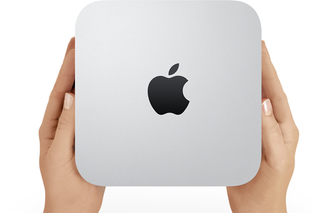IT Pro Verdict
Apple's Mac mini doesn't look any different to last year's version, but this doesn't matter because the design and build quality is outstanding. The Fusion Drive is a luxurious addition and Ivy Bridge upgrades provide plenty of power but these optional upgrades don't come cheap - unless you've got money to burn, the low-end models are more affordable and almost as impressive.
It's not like Apple to leave one of its machines without any design changes from one year to the next, but that's exactly what's happened with the latest version of the Mac mini.
Although things may appear the same on the outside, things have been beefed up within.
The key upgrades include the debut of the Fusion Drive and introduction of Intel Ivy Bridge processors. These help to ensure this is the best-performing Mac mini ever, but you wouldn't know it at first glance - this year's model looks identical to its predecessor, and its dimensions have remained the same: 197mm wide, and with a height of just 36mm.
It's not ugly or dated: the curved corners, flat top and aluminium construction ensure it's better looking than every small-form-factor business machine. Build quality is beyond reproach too.
Fusion Drive was introduced in the latest iMac, is the Fusion Drive. The concept is similar to Intel's Smart Responsive Technology, but it goes one step further by strapping a 128GB SSD to a 1TB hard disk. That's double the amount of space supported by Intel's system, and it works in a much more advanced way: OS X and key applications are stored on the SSD for increased responsiveness, while rarely-used software is relegated to the hard disk to preserve system performance.

OS X manages interaction between the SSD and hard disk by itself, so there's no way for the user to intervene. Out-of-the-box, the OS and several of Apple's key apps are installed to the SSD, and the system monitors your behaviour over time - if apps aren't used, they're moved to the hard disk. New software is automatically installed to the SSD as long as there's room.
Windows users aren't able to access these benefits, however. Those installing Microsoft's OS via Apple's Boot Camp are only able to partition the hard disk.
The benefits of the Fusion Drive will only become obvious over time, but we're still able to test the raw speed of the SSD thanks to OS X benchmarking tool Xbench. The drive scored 277MB/s and 315MB/s in Xbench's sequential read and write benchmarks - much quicker than even the fastest hard disk, even if it's not able to match the 302MB/s and 364MB/s of the Fusion Drive in the latest iMac.
Specification and performance
Apple's other hardware update also follows in the iMac's footsteps, with Ivy Bridge processors replacing the Sandy Bridge technology employed in older Mac minis. There's no sign of desktop chips here, though - this PC is too small, so Apple has had to turn to Intel's mobile parts.
That's not to say the Core i7-3720QM used in this particular Mac mini is found wanting in the power department. Its base clock of 2.6GHz is reasonable, it's got four physical cores, and its Turbo Boost stats are impressive: all four cores can hit a peak of 3.4GHz, with one core able to go an additional 200MHz faster.
The chip is aided by 4GB of DDR3 RAM and scored 0.93 in our benchmarks. That's barely behind the 0.96 scored by the latest iMac, and it's a much more impressive score than the 0.72 result of the Core i5 chip in 2011's machine.
There's enough application power to handle all but the most demanding of business software, but don't expect the Mac mini to handle graphical tasks just as well. Intel's HD 4000 graphics chip scored a mediocre 57fps in our Low-quality Crysis test, and there's now no option to included a discrete GPU. That's a poorer result than the last Mac mini, which had an AMD Radeon HD 6630M and scored 69fps in our Low-quality benchmark.
It's easy to see why Apple hasn't chosen more powerful parts than the Core i7 included here - when tested in both OS X and Windows, the quad-core chip peaked at around 100C. That's almost at the thermal envelope of this particular part and, while the system never became unstable, it's a cause for concern. Power draw was more impressive, though, with the system idling at just 18W and peaking at 73W.
Mike Jennings has worked as a technology journalist for more than a decade and has been fascinated by computers since childhood, when he spent far too long building terrible websites. He loves desktop PCs, components, laptops and anything to do with the latest hardware.
Mike worked as a staff writer at PC Pro magazine in London for seven years, and during that time wrote for a variety of other tech titles, including Custom PC, Micro Mart and Computer Shopper. Since 2013, he’s been a freelance tech writer, and writes regularly for titles like Wired, TechRadar, Stuff, TechSpot, IT Pro, TrustedReviews and TechAdvisor. He still loves tech and covers everything from the latest business hardware and software to high-end gaming gear, and you’ll find him on plenty of sites writing reviews, features and guides on a vast range of topics.
You can email Mike at mike@mike-jennings.net, or find him on Twitter at @mikejjennings

